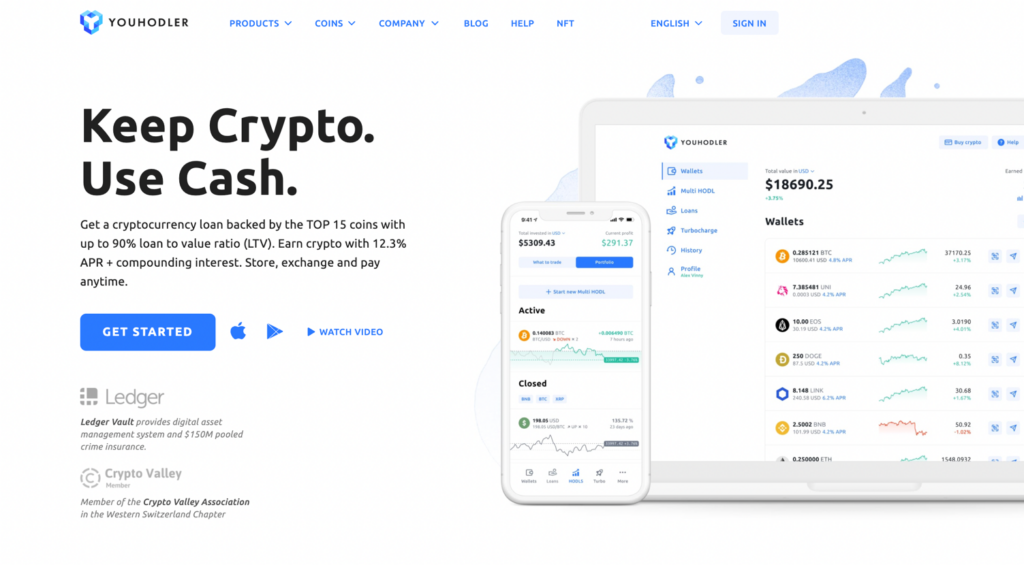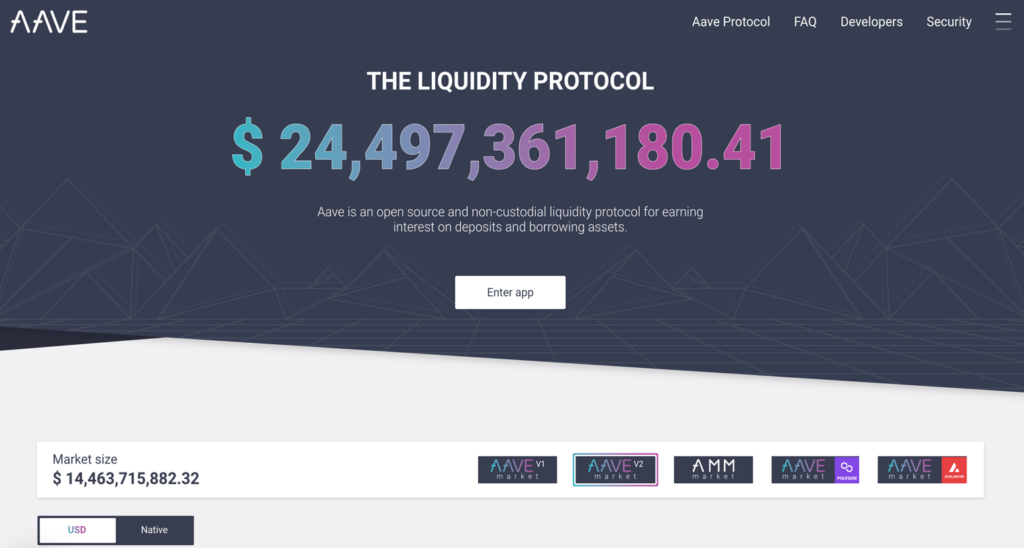Loans offered without any credit checks, all approved and paid out in minutes to hours; is that even possible? This is the world of crypto lending, an innovative method of allowing credit lines using cryptocurrencies as collateral instead of traditional unsecured loans.
Of course, if you want to loan crypto, you’ll need to choose the best possible lending platform. The world of digital currencies is still quite confusing for the average Joe. Hence, this article aims to demystify crypto lending and ultimately provide a framework for choosing the most excellent platforms in this realm.
What is crypto lending?
Crypto lending involves collateralized loans with cryptocurrencies. This type of credit does not entail any pre-qualified verification processes like credit checks, as with conventional loans.
Hence, it is one of the main advantages of crypto lending, thanks to the permissionless and highly efficient nature of blockchain and smart contract technology governing the capital and loan agreements.
The main requirement is for borrowers to put up some security in a supported fiat or digital cryptocurrency in exchange for another digital or fiat currency. Three parties involved are in a crypto backed loan; the lenders, borrowers, and crypto lending platforms (or exchanges) as the go-between.
Lenders essentially ‘stake’ their idle holdings to the lending platforms in return for earning interest. On average, one can expect to gain from 7-11% APY (annual percentage yield) for stablecoin deposits, while 3-6% for crypto deposits.
Of course, platforms deal with the back-end and charge interest (and sometimes other fees) for their services. Crypto lending services offer long and even unlimited loaning terms with flexible repayment plans.
How does crypto lending work?
As briefly established, the concept behind crypto loans is borrowing funds using digital currencies as security without going through any of the rigmarole you’d experience with a conventional financial institution.
Although this quality is an advantage, it’s also a drawback because of the risks involved. With a traditional collateralized loan, the borrower allocates security equal to the value of the credit they’d receive and no more (aside from admin and interest fees).
Yet, with a crypto backed loan, they need to put up more in worth (known as over-collateralization). This mechanism is in place primarily to mitigate defaulting and price volatility risks.
Crypto lending platforms and exchanges use what’s known as the loan-to-value (LTV) ratio, which expresses the loan amount in relation to the collateral value.
Typically, most crypto lending platforms enforce a 50% LTV ratio (some can go up to 90%). This means if you wanted to borrow $2500 worth of funds, you would need to secure $5 000 as collateral (2500/5000 X 100 = 50%).
If the LTV ratio was 62.5%, the borrower would need to set aside $4000 as security (2500/4000 X 100 = 62.5).
Should the collateral fall in price below a certain threshold, one would be urged to deposit more, partially repay the balance, or the platform would automatically liquidate the entire crypto loan (effectively a margin call).
Conversely, if the collateral rose in value during the loan term, the borrower is free to withdraw some of those funds or borrow more. Mitigating price volatility, which tends to be unpredictable in cryptocurrencies, is one of the primary purposes for over-collateralization.
Crypto lending platforms levy daily-chargeable interest rates (and sometimes admin fees), which vary in extent depending on whether you’re using fiat or crypto to borrow, and other conditions.
Most services in this realm don’t enforce any monthly installment plan for long-term crypto loans and often no penalties for early settlement. Below are the main steps involved in crypto lending:
- Borrowers approach crypto lending services for a loan, specifying duration and amount.
- The platforms automatically evaluate the request based on their parameters and reveal how much the collateral will be.
- Borrowers will then stake the required crypto collateral (before the lenders’ deposited assets are used to fulfill the loan.) The latter typically collect interest weekly as a portion of the APY from the platform.
- After the borrower repays the credit with interest, they receive their collateral back.
Differences between a centralized and decentralized platform
Just as exchanges are either centralized (CeFi = centralized finance) or decentralized (DeFi = decentralized finance), so are crypto lending platforms.
The primary distinction is the former involves an actual company behind the onboarding process while the latter is more autonomous through the use of an algorithmic protocol without an official middleman.
Therefore, CeFI facilities are often regulated in their respective and perhaps several other jurisdictions, while with DeFi, this isn’t the case. As a result, the former generally employs more recognized safety measures, providing peace of mind, particularly for beginners.
Yet, if you prefer to trade anonymously for privacy concerns, DeFi is the way to go (although such services don’t provide as much security).
Another difference is CeFI platforms allow for borrowing using fiat and crypto, while DeFi facilities are always crypto-focused. Furthermore, the former services may have withdrawal limits based on certain verification tiers, while the latter usually don’t.
The table below details the primary differences between the two. Ultimately, one isn’t necessarily superior to the other as, like most things, it depends on your preferences, needs, and what’s being offered.
| Centralized platforms | Decentralized platforms | |
|---|---|---|
| Hosting | Centralized servers | Distributed network |
| Security | More | Less |
| Identity verification | KYC is necessary | No KYC is necessary |
| Regulated | Yes | No |
| Private keys custody | Held with the platform | Held with the user |
| User-friendliness | Better | Not as good |
| Withdrawal limits | Yes | No |
| Deposit and withdrawal currencies | Fiat and crypto | Crypto only |
| Customer support | Plenty | Limited |
Things to consider when choosing a crypto lending platform
We’ve outlined the main considerations below to observe when choosing a crypto lending platform in ensuring you arrive at the most optimal decision.
Type of lending platform
Is it centralized or decentralized, regulated or unregulated? Someone may prefer DeFi platforms because they retain access to their private keys, which most consider personal data. Furthermore, no identity verification is required with these services, which is also sensitive information.
A centralized crypto lending platform takes custody of the private keys and implements a KYC (Know-Your-Customer) process for onboarding clients. In this regard, your choice between the two depends on how comfortable you are with private data and security overall.
Risks exist in using either of such facilities when you loan crypto. There’s also a perception that decentralized services are more prone to large-scale hacking events while their counterparts aren’t.
Also, most generally believe decentralized platforms are less user-friendly and accessible, catering more towards experienced people. However, DeFi services offer innovative products (flash loans, interest rate switching, etc.), which their equivalents don’t.
Overall, these are some of the considerations to note before observing other details.
Safety / Security
Like any financial product, safety is paramount. In this regard, CeFi platforms tend to come out on top. The security features to contemplate include insurance, proof of reserves, cold wallet storage, anti-money laundering policies, extra platform authentication, customer support, etc.
Before deciding on an option, study how you will navigate the platform in question to ensure the most secure user experience.
Minimum amount for lending / borrowing
Is it $100, $1000, or more? From a borrowing perspective, it’s obviously best to choose a crypto loan service with the lowest possible deposit. Some platforms like BlockFi, while reputable and highly recognized, require at least $10 000 for borrowing.
For lenders, they should also share a similar sentiment; the lower, the better.
Interest rate
This factor goes without saying; lenders prefer crypto lending platforms offering the highest possible interest, while borrowers seek services providing the lowest. Generally, most facilities incentivize users more when lending with a stablecoin like USDT (Tether), USDC (USD Coin), DAI, etc.
When you borrow a stablecoin rather than a fiat or digital currency, your interest rates are likely to be lower.
LTV ratio
This aspect is arguably the most crucial from a borrowing perspective. To simplify, the higher the LTV ratio, the better for the borrower because the extent of over-collateralizing is lessened.
The industry standard seems to be 50%, though some platforms go as high as 90%. Yet, the greater the LTV ratio becomes, the shorter the lending duration (usually 30 days maximum).
Additionally, crypto lending platforms provide better LTV ratios for stablecoins than regular cryptocurrencies since the former offers stability in price movements.
Lending duration and flexibility
Users will need to ask themselves how long they plan to borrow and consider their repayment frequency. Some platforms have an unlimited lending duration and adopt a pay-as-you-go policy rather than stipulating specific monthly payments.
Others may have a limited period for borrowing. What about any penalties for late or early payment? Does the platform allow multiple crypto loans simultaneously? These are some of the questions to examine.
It’s ideal to choose crypto lending platforms offering more flexibility and an unlimited lending duration. Yet, much of this will depend on what you’re borrowing, the LTV ratio, etc.
Supported collateral and loan currencies
With this factor, the more the merrier. If a crypto lending platform has a limited range, users must make a few conversions through other services before using the supported digital asset or seek other protocols or facilities.
So, the more digital currencies available for depositing (for lending and collateral), the better overall. The choice decision is also essential for the currencies borrowers receive on their side. Again, the more the merrier.
Geo-restrictions
Crypto lending platforms do not serve clients from all countries worldwide, which is particularly a challenge if you’re an American citizen because of the country’s negative stance on using cryptocurrencies.
So, as expected, make sure the crypto loan service you are considering is allowed to serve clients in your region.
Risks involved with crypto lending
Crypto lending certainly presents some notable advantages; accessibility, automation, cost-effectiveness, and quickness. Yet, it also possesses arguably more drawbacks than traditional lending.
- Volatility risks: Over-collateralization is one of the banes of crypto lending from a borrower’s perspective.
It’s a greater financial risk as you need to put up more than the amount you’re borrowing, making the lending process inherently more expensive from the get-go (without even considering interest and other possible fees).
Lenders aren’t immune to the volatility challenges. Although they earn interest, the value of their crypto assets can fluctuate wildly in price due to the innately volatile nature of cryptocurrencies.
This means your assets may be worth less overall after the lending duration has ended, even with additional interest rewards. One of the solutions to this problem is for investors to lend using stablecoins.
These coins shield one from any volatility (as they are typically backed 1:1 to the dollar or other fiat currency) and offer better returns than standard cryptocurrencies like Bitcoin and Ethereum.
- Technical risks: In this aspect, there are always chances of hacking, especially with DeFi platforms (and, to some extent, CeFi platforms as well). The latter is more prone to such attacks since they are mostly autonomously governed.
Expert hackers and cybercriminals are constantly looking for code vulnerabilities in even the most secure crypto lending platforms, resulting in some theft of users’ funds worth millions.
Hence, as a lender or borrower, you need to appreciate your funds aren’t 100% safe. Moreover, because cryptocurrencies are largely unregulated presently, financial remedy is not guaranteed in such circumstances.
- Counterparty risks: This danger links back to the previous one. The purpose of over-collateralization is primarily mitigating the volatility risks, yet it cannot fully safeguard against this.
Very few crypto lending platforms can fully prepare against an unexpected market crash, a swarm of defaulting clients, or disastrous technical breakdowns. Such services may not have enough money or liquidity to return borrowers’ collateral and the crypto deposited by the lenders/investors in any of these situations.
Which are the top crypto lending platforms for 2021?
Now that we’ve covered some beneficial education on crypto backed loans let’s dive into the five best options in this space through a brief review and a summary of the pros and cons.
Nexo: Best Overall

Nexo is one of the most prominent and reputable CeFi crypto lending institutions globally, serving more than 2.5 million clients in more than 200 countries. The Swiss-based company claims to have paid over $50 million in interest since its 2018 inception while presently managing over $4 billion in assets.
Among other innovative products, the main crypto loan service with Nexo is Instant Crypto Credit Lines™. Borrowers pay between 6.9% and 13.9% APY, with instant-approval loans starting from $50 (for USDT and USDC) and $500 (for fiat currency).
There are 24 options to select for collateral purposes, with LTV ratios ranging from 50% to 90% depending on the asset. As a lender, one anticipates earning up to 17% APY, with the luxury of a wide crypto selection to invest with.
Like many crypto lending platforms, NEXO has its own utility token of the same name for users to receive interest discounts and other incentives. Nexo promises no hidden fees or extra commissions for withdrawing, adding, and holding funds.
Overall, Nexo tops the list for reasonable minimum deposits, industry-standard interest rates, loan flexibility, competitive LTV ratios, cryptocurrency selection, top-notch security, and low geo-restrictions.
Pros:
- Regulated entity
- Attractive LTV ratios (up to 90% on some assets)
- Supports 40+ fiat currencies for borrowing and 24 digital currencies for earning/lending
- Industry-leading interest rates for borrowing (between 6.9% and 13.9%)
- $50 minimum borrowing amount
- Unlimited lending period with no installments
Cons:
- Withdrawal limits apply based on the verification level
YouHodler: Top Crypto Lending Service With One Of The Highest LTV Ratios

YouHodler is a globally popular Cyprus-based crypto lending facility started in 2017 with an additional office in Switzerland.
Within their suite of trading, wallet, saving accounts, and payment solutions are crypto loans where borrowers can collateralize with over 30 options (including several stablecoins) to borrow in USD, EUR, CHF, GBP, USDT, or BTC at competitive interest rates.
‘Hodlers’ or investors should expect yields of up to 12% APY through YouHodler’s savings accounts by receiving weekly interest with a broad range of cryptocurrencies and stablecoins. Borrowing and earning each starts from a reasonable $100.
The platform provides flexible LTV ratios starting from 50% (for max 180 days) to 90% (for between 15-30 days). Like its close competitor, YouHodler is an equally superior crypto lending service catering to all the needs of the modern-day borrower and hodler.
Pros:
- Allows withdrawals via crypto, credit card, and bank wire
- LTV ratios up to 90%
- Licensed company with strong security measures
- Broad selection of cryptocurrencies to collateralize with and earn yields
- $100 minimum loan amount
- Fast approvals
Cons:
- Fiat withdrawals only available in limited countries
- Users can only borrow USD, EUR, CHF, GBP, USDT, or BTC
Celsius: Excellent Crypto Lending Platform With No Minimum Deposit

Since 2018, Celsius has always been about ‘unbanking yourself’ by providing modern and user-friendly lending services through cryptocurrencies, unlike traditional finance firms.
The brand prides itself on competitive interest rates, low fees, wavering extra bank-like costs, and fast transactions. Celsius is headquartered in London, with additional offices in America and Lithuania.
The company claims to manage close to $30 billion in assets, serves more than 1 million clients, and has paid close to $1 billion in rewards since inception. Celsius prioritizes higher rates for earners and lower rates for borrowers with the motto ‘earn high, borrow low.’
CEL, the platform’s utility token (presently ranked #109 by CoinMarketCap for most traded cryptocurrencies), offers even more incentives. With CEL, the service provides up to a 30% discount on interest payments for borrowers, up to 25% extra in rewards for investors, and other user-related benefits.
Celsius provides over 30 cryptocurrencies as collateral options to borrow numerous stablecoins (with up to 90% LTV), while investors can earn rewards from a similar range of coins.
All in all, Celsius’ curated product suite was designed to truly disrupt the financial industry, making it one of the best platforms for crypto lending.
Pros:
- Provides the most competitive interest rates
- Wide selection of digital asset options for borrowing and earning
- No minimum deposit requirement, and minimal fees
- Accepts US clients (but they can’t use all services)
- Registered with FinCEN
- Incentives offered for using the CEL token
Cons:
- Low LTV ratios on average
- Users can’t borrow any fiat currencies
Aave: Best DeFi Crypto Lending Platform

Many consider Aave (meaning ‘ghost’ in Finnish) as one of the early adopters of DeFi when it first began as the lending platform, ETHLend, in 2017. The platform specialized in collateralized lending using cryptocurrencies, a novel concept back then.
It rebranded in September 2018 to Aave and steadily grew to become of the most popular platforms for users to lend and borrow digital assets in various pools. For borrowing and earning yields, Aave provides 31 Ethereum-built cryptocurrencies like BNB, USDT, LINK, etc.
Due to this choice, Aave currently offers a 36.66% APY for lending BUSD (Binance USD), one of the highest rates on their platform. Aave’s LTV ratios go up to 80%, depending on the cryptocurrency.
One of the unique things with Aave is flash loans, an instant uncollateralized loan. This facility requires the borrower to return the funds within seconds, and is used primarily for arbitrage, collateral swaps, and loan refinancing.
Aave also has its utility token, AAVE (presently ranked #47 by CoinMarketCap for most traded cryptocurrencies), providing holders better lending and borrowing interest rates, staking, and governance power.
Ultimately, if you’re a more sophisticated investor or user who prefers non-custodial platforms, then Aave is a worthy choice.
Pros:
- Decentralized lending platform
- LTV ratio of up to 70%
- Offers flash loans
- Extra incentives for using the AAVE token
- Provides fixed and variable interest rates
Cons:
- No mobile app is available
- Uses a slightly complex model for determining interest rates and collateralization
- Only works with Ethereum-based tokens
Yearn.finance: Great Crypto Lending Platform Aggregator

Despite only launching in February 2020, Yearn.finance (formerly known as iEarn) rebranded seven months later to become one of the formidable DeFi services in the space.
Yearn is essentially a decentralized yield farming aggregator. Yield farming is where crypto investors stake their holdings for a yield like how lenders do with lending platforms.
As an aggregator, Yearn employs sophisticated tools to aggregate the best possible interest rates from other DeFi facilities like Compound, Aave, dYdX, Curve, and more.
By simply connecting your crypto wallet to Yearn, you can find the highest possible yields for an expansive range of cryptocurrencies with minimal effort.
Like all DeFi facilities, Yearn runs autonomously using code without a central custodian’s reliance. The platform allows anyone to become a liquidity provider by staking any of the offered coins for interest rewards
Yearn has its own governance token, YFI (presently ranked #93 by CoinMarketCap for most traded cryptocurrencies), which users can receive for providing liquidity and voting on governance decisions within the platform.
Overall, Yearn.finance may be a worthy consideration for those interested only in lending and prefer some of the benefits decentralized platforms provide.
Pros:
- One of the leading DeFi yield farming aggregators
- More privacy and no signup process as a DeFi protocol
- Aggregation finds the highest possible interest rates from multiple platforms
- Provides extra incentives with its utility token, YFI
Cons:
- Not particularly user-friendly
- Does not provide borrowing services; only lending
- Has faced common DeFi security issues in the past
FAQs about the top crypto lending platforms for 2021
Can you lose money lending crypto?
Yes, it’s possible to lose money from lending and borrowing, and it’s something frequently occurring. Cryptocurrencies are inherently volatile and can dip in value considerably for extended periods.
Other dangers include technical and counterparty risks, as mentioned in a previous section. Hence, one needs to be experienced with cryptocurrencies, appreciate that security is never fully guaranteed, and perform the necessary due diligence in any potential lending platform.
Can you get a crypto loan without collateral?
For the most part, no, except with flash loans provided by the likes of Aave. It’s crucial to understand this credit line was not designed for conventional long-term lending since users need to pay it back within seconds.
What happens if you don’t pay your crypto loan?
The platform uses your collateral in the likely case of default. So, in this scenario, you would lose this security.
How much can I make lending crypto?
Aside from the potential natural appreciation of the digital currencies, this depends on the yields offered. Currently, standard coins provide users between 2-8% on average, while stablecoins range from 10-18% APY.








